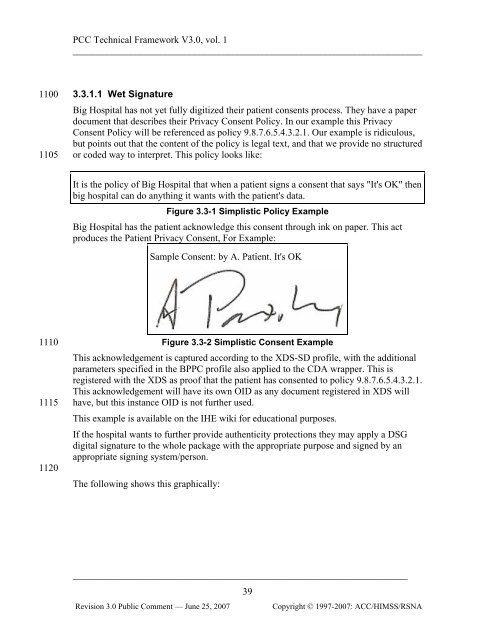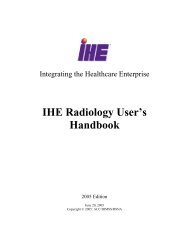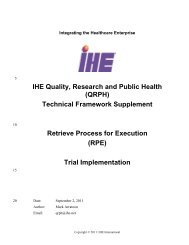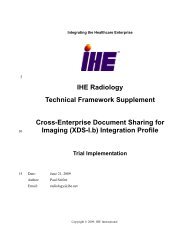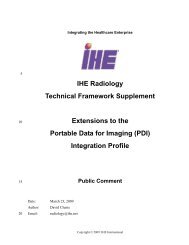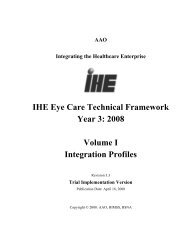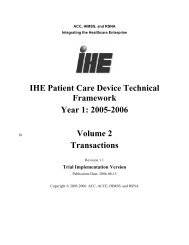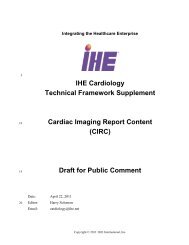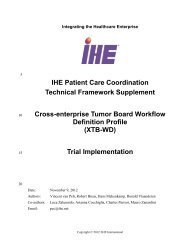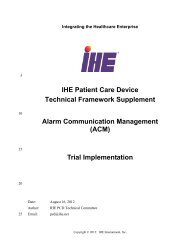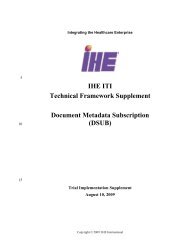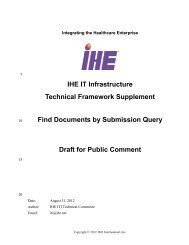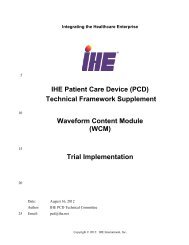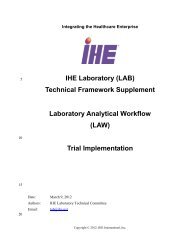IHE Patient Care Coordination Technical Framework Vol I
IHE Patient Care Coordination Technical Framework Vol I
IHE Patient Care Coordination Technical Framework Vol I
You also want an ePaper? Increase the reach of your titles
YUMPU automatically turns print PDFs into web optimized ePapers that Google loves.
PCC <strong>Technical</strong> <strong>Framework</strong> V3.0, vol. 1<br />
________________________________________________________________________<br />
1100<br />
1105<br />
3.3.1.1 Wet Signature<br />
Big Hospital has not yet fully digitized their patient consents process. They have a paper<br />
document that describes their Privacy Consent Policy. In our example this Privacy<br />
Consent Policy will be referenced as policy 9.8.7.6.5.4.3.2.1. Our example is ridiculous,<br />
but points out that the content of the policy is legal text, and that we provide no structured<br />
or coded way to interpret. This policy looks like:<br />
It is the policy of Big Hospital that when a patient signs a consent that says "It's OK" then<br />
big hospital can do anything it wants with the patient's data.<br />
Figure 3.3-1 Simplistic Policy Example<br />
Big Hospital has the patient acknowledge this consent through ink on paper. This act<br />
produces the <strong>Patient</strong> Privacy Consent, For Example:<br />
Sample Consent: by A. <strong>Patient</strong>. It's OK<br />
1110<br />
1115<br />
1120<br />
Figure 3.3-2 Simplistic Consent Example<br />
This acknowledgement is captured according to the XDS-SD profile, with the additional<br />
parameters specified in the BPPC profile also applied to the CDA wrapper. This is<br />
registered with the XDS as proof that the patient has consented to policy 9.8.7.6.5.4.3.2.1.<br />
This acknowledgement will have its own OID as any document registered in XDS will<br />
have, but this instance OID is not further used.<br />
This example is available on the <strong>IHE</strong> wiki for educational purposes.<br />
If the hospital wants to further provide authenticity protections they may apply a DSG<br />
digital signature to the whole package with the appropriate purpose and signed by an<br />
appropriate signing system/person.<br />
The following shows this graphically:<br />
_____________________________________________________________________<br />
39<br />
Revision 3.0 Public Comment — June 25, 2007<br />
Copyright © 1997-2007: ACC/HIMSS/RSNA


